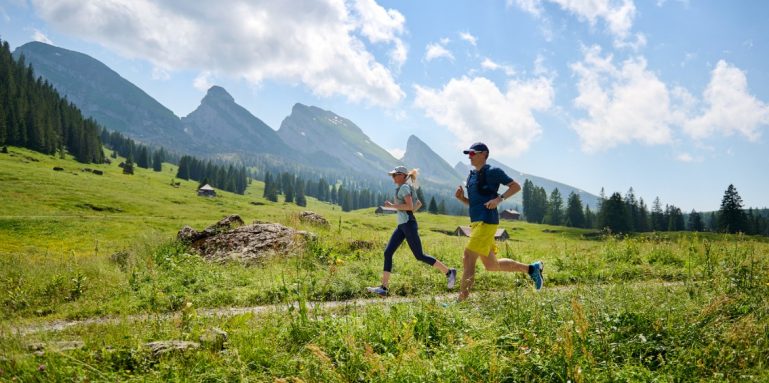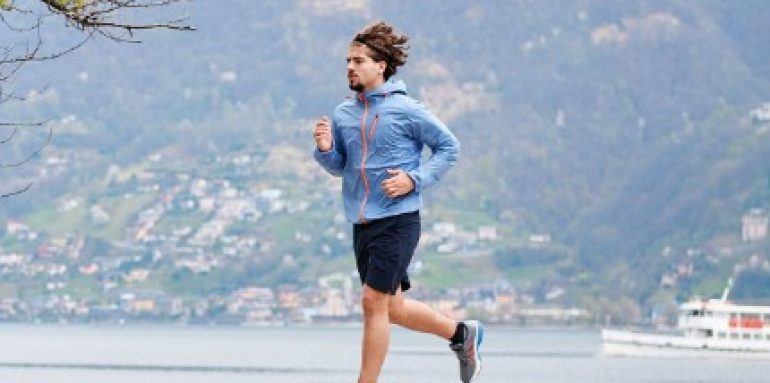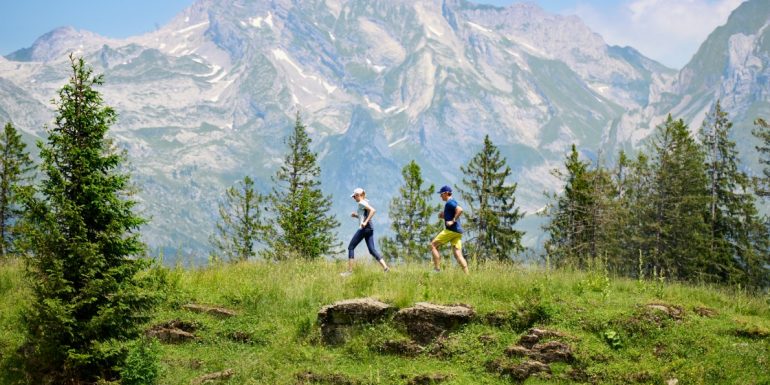
Trail running: run safely off-road
Put on your running shoes and get outdoors. Compared to running on paved roads, running on unpaved paths is a full-body workout. It improves your stamina, coordination and concentration. These tips will help you to run safely on your first trails.
Trail running is becoming increasingly popular, which isn’t surprising, as running on uneven paths is an effective full-body workout. It helps to clear your head – and promises some stunning moments in nature.
Trail running or jogging – what’s the difference?
The biggest difference between trail running and jogging is the terrain you run on. As a general rule, a trail is not signposted, and is not a paved footpath. The type of terrain ranges from the forest at the edge of the city, to a trail through the park, through to challenging trails high in the mountains – mountain running is a variant of trail running, but not the definition of it. This variety means the training is very diverse.
Move. Earn points. Benefit.
Helsana+ rewards your dedication, whether you’re jogging, walking or hiking. Simply download the Helsana+ app, connect your tracker watch or smartphone and start collecting points. Your activity will earn you valuable Plus points that you can convert into cash, vouchers or donations. You can collect over CHF 300 per year.
Do I need any special equipment?
If you’re a regular jogger, you don’t need to buy a whole new wardrobe. Breathable clothing and the right shoes are essential for any type of running. However, you should wear trainers designed for trail running. Their soles give you more grip on unpaved paths, which helps you to avoid injuries. If you want to go on longer runs, a drink belt or a running backpack with an integrated drink system is recommended. The equipment gets a bit more specialised for Alpine terrain, where the following basics are required:
- Light windbreaker or rain jacket
- Running backpack
- Thermal blanket
- Sun protection
- First aid kit
- Trail running poles
- Map or GPS
- Head torch
- Energy bars
How do I prepare for a trail run?
For trail running, you need to be in good basic shape. If you are an experienced jogger, already have the necessary equipment and feel like you are in shape, you can head to the trails. Ideally, you should integrate the ABCs of running exercises prior to going trail running. After all, the better your running technique, the less likely you are to get injured. This is also the case for trail running. Go at a slower pace if you do not have a lot of experience.
Test your body on easier trails to see how it reacts to the uneven terrain – your ankles and knee muscles have to work a lot harder. Train your stamina, muscle strength and coordination skills before attempting any of the more adventurous trails. Plus, keep in mind that at higher altitudes, your performance will drop sharply, as there is less oxygen in the air. Mountain running is harder than a trail run on a flat route.
Do you want to improve your running technique so you can avoid typical beginners’ mistakes? Find out how to avoid stresses, and even injuries.
Which areas of the body should I train for trail running?
Unlike in jogging, trail running is much more strenuous and demands more from different muscle groups. If the terrain is stony or if there are lots of roots, this trains the feet. If you are going up a mountain, you strengthen your buttocks, back, thighs and calves. When you run down a mountain, the pressure is focussed on the forefoot. The uneven ground strengthens your ankles, as your feet never land on the ground the same way, so they are subjected to different loads with each step. Well-trained ankles take the pressure off the knees and protect you from strain, which has a positive effect on your back.
What do I need to bear in mind when Alpine trail running?
Over time, you might find yourself wanting to try out some more challenging routes in Alpine terrain. Most do start in the valley. Mountain running has many physical advantages. The different position your body is in means that different muscle groups experience different strain, and therefore different training goals can be achieved. At the same time, the high altitude also strengthens your cardiovascular system.
Avoid overexertion. On steep sections – or whenever your body tells you – revert to power walking. Special trail running poles are also recommended. They take the pressure off your leg muscles. Thanks to the additional propulsion, a faster tempo is possible uphill and you can keep a faster tempo over longer periods of time.
The poles also provide runners with some safety, and make your footing more secure when off-road. It’s also worth pacing yourself. What goes up must come down – and coming down is more strenuous on your muscles.
At high altitudes, you might come across snow or ice, depending on the season. To be safe, bring spikes for your trail shoes, so you can safely run over slippery surfaces.
The big advantage of running in the mountains is the breathtaking panoramas, which also make you feel happier.
- Am I feeling fit enough for the planned run today?
- Look at weather forecasts – the weather can quickly change in the mountains
- Water and food are a must
- When does the last cable car leave?
- Make sure your phone has enough battery. Bring a power bank with you if you need to.
- Check your insurance to make sure you are covered for mountain rescue
- If you are running alone, tell someone your route
Seven tips for starting trail running
1. Less is more
Even if you are an experienced jogger, start your trail runs on even ground with small inclines before you attempt a challenging mountain run. This way, your body can slowly get used to the different strain. At the start, don’t run any more than two or three times a week and only attempt routes of around five kilometres.
2. Take a break
Ambition is good, but trail running doesn’t actually involve running the whole way. Go up the mountain at a brisk pace. Even experienced trail runners switch to power hiking on steep sections. It is totally normal, and more efficient.
3. Train for ascents first, then descents
If you have the stamina for ascents, you can then attempt descents. When going downhill, avoid using the classic heel striking technique. On downhill slopes, you risk injuring yourself – above all, you could sprain your ankle. If you land on your forefoot instead, and let your legs do the work, it absorbs the shock better. And less impact means less muscle cramps and aches.
4. Don’t get distracted
The uneven terrain has its pitfalls. Stony ground, branches, roots – the risk of stumbling is a lot higher when trail running than when jogging in the city. Which is why running in the great outdoors requires a great deal of concentration. Want to take a look at your phone? It’s better to do so once you’ve stopped for a break.
5. Don’t overestimate yourself
When trail running, things happen fast: a wet stone, a daring leap over a root – the landing is hard, and on slippery ground, it’s uncoordinated. You could sprain your ankle, tear a ligament, or worse. Slow down when you feel tired, or walk for a bit to reserve energy – the more tired you are, the more likely you are to injure yourself.
6. Don’t run too late in the evening
Running gets your circulation going. For beginners, your body needs a couple of hours to calm down after running. Don’t go on any intense runs late in the evening, as it could reduce the quality of your sleep, which would impact your recovery.
7. Run together
Ideally, join a trail running group or find a running buddy. Running in Alpine areas can be extremely challenging. In a group, you can motivate each other, advise each other about the route, and in case of an injury, quickly get help. Are you looking for a trail running club in your area?
If you’ve decided to take up trail running, you’ll be rewarded with stable joints, stronger muscles, a clear head and inner peace. What more could you want?

Sports scientist Joy provided the editorial team with advice and input for this article. Joy Marxer (MSc in Sports Rehabilitation and Prevention) works for Helsana health consultation. She supports customers on questions to do with exercise and sports medicine.


Newsletter
Find out more about current health issues every month and get all the information you need about our attractive offers from all Helsana Group companies * delivered by e-mail to read whenever it suits you. Our newsletter is free of charge and you can sign up here:
- Ms
- Mr
We did not receive your information. Please try again later.
* The Helsana Group comprises Helsana Insurance Company Ltd, Helsana Supplementary Insurances Ltd and Helsana Accidents Ltd.
